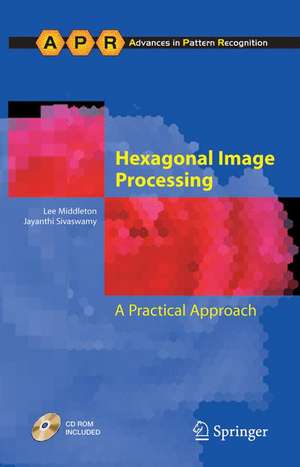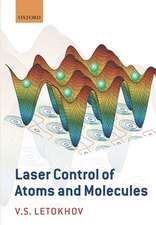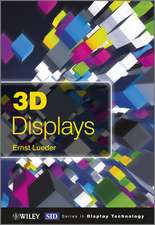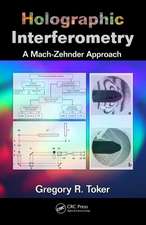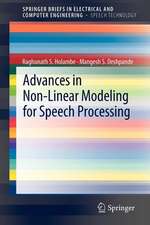Hexagonal Image Processing: A Practical Approach: Advances in Computer Vision and Pattern Recognition
Autor Lee Middleton, Jayanthi Sivaswamyen Limba Engleză Mixed media product – 16 aug 2005
| Toate formatele și edițiile | Preț | Express |
|---|---|---|
| Paperback (1) | 639.25 lei 6-8 săpt. | |
| SPRINGER LONDON – 22 noi 2014 | 639.25 lei 6-8 săpt. | |
| Mixed media product (1) | 643.99 lei 6-8 săpt. | |
| SPRINGER LONDON – 16 aug 2005 | 643.99 lei 6-8 săpt. |
Din seria Advances in Computer Vision and Pattern Recognition
- 20%
 Preț: 998.36 lei
Preț: 998.36 lei - 20%
 Preț: 409.80 lei
Preț: 409.80 lei - 20%
 Preț: 654.70 lei
Preț: 654.70 lei - 20%
 Preț: 775.30 lei
Preț: 775.30 lei - 20%
 Preț: 867.15 lei
Preț: 867.15 lei - 20%
 Preț: 241.87 lei
Preț: 241.87 lei - 20%
 Preț: 659.83 lei
Preț: 659.83 lei - 20%
 Preț: 1084.17 lei
Preț: 1084.17 lei - 20%
 Preț: 328.60 lei
Preț: 328.60 lei - 20%
 Preț: 650.08 lei
Preț: 650.08 lei - 20%
 Preț: 644.66 lei
Preț: 644.66 lei - 20%
 Preț: 652.54 lei
Preț: 652.54 lei - 20%
 Preț: 646.80 lei
Preț: 646.80 lei - 20%
 Preț: 993.60 lei
Preț: 993.60 lei - 20%
 Preț: 1174.92 lei
Preț: 1174.92 lei - 20%
 Preț: 646.80 lei
Preț: 646.80 lei - 20%
 Preț: 672.36 lei
Preț: 672.36 lei - 20%
 Preț: 1166.52 lei
Preț: 1166.52 lei - 20%
 Preț: 920.33 lei
Preț: 920.33 lei - 20%
 Preț: 825.78 lei
Preț: 825.78 lei - 20%
 Preț: 666.58 lei
Preț: 666.58 lei - 18%
 Preț: 953.65 lei
Preț: 953.65 lei - 20%
 Preț: 999.35 lei
Preț: 999.35 lei - 20%
 Preț: 655.02 lei
Preț: 655.02 lei - 20%
 Preț: 595.16 lei
Preț: 595.16 lei - 20%
 Preț: 647.61 lei
Preț: 647.61 lei - 20%
 Preț: 658.33 lei
Preț: 658.33 lei - 20%
 Preț: 1649.61 lei
Preț: 1649.61 lei - 20%
 Preț: 991.46 lei
Preț: 991.46 lei - 20%
 Preț: 994.08 lei
Preț: 994.08 lei - 20%
 Preț: 1062.57 lei
Preț: 1062.57 lei - 20%
 Preț: 985.16 lei
Preț: 985.16 lei - 20%
 Preț: 640.35 lei
Preț: 640.35 lei - 20%
 Preț: 656.03 lei
Preț: 656.03 lei - 18%
 Preț: 950.52 lei
Preț: 950.52 lei - 20%
 Preț: 652.41 lei
Preț: 652.41 lei - 20%
 Preț: 644.81 lei
Preț: 644.81 lei - 20%
 Preț: 996.40 lei
Preț: 996.40 lei
Preț: 643.99 lei
Preț vechi: 757.63 lei
-15% Nou
Puncte Express: 966
Preț estimativ în valută:
123.24€ • 133.82$ • 103.52£
123.24€ • 133.82$ • 103.52£
Carte tipărită la comandă
Livrare economică 22 aprilie-06 mai
Preluare comenzi: 021 569.72.76
Specificații
ISBN-13: 9781852339142
ISBN-10: 1852339144
Pagini: 272
Ilustrații: XIII, 254 p. With CD-ROM.
Dimensiuni: 155 x 235 x 20 mm
Greutate: 0.52 kg
Ediția:2005
Editura: SPRINGER LONDON
Colecția Springer
Seria Advances in Computer Vision and Pattern Recognition
Locul publicării:London, United Kingdom
ISBN-10: 1852339144
Pagini: 272
Ilustrații: XIII, 254 p. With CD-ROM.
Dimensiuni: 155 x 235 x 20 mm
Greutate: 0.52 kg
Ediția:2005
Editura: SPRINGER LONDON
Colecția Springer
Seria Advances in Computer Vision and Pattern Recognition
Locul publicării:London, United Kingdom
Public țintă
ResearchCuprins
Current approaches to vision.- The Proposed HIP Framework.- Image processing within the HIP framework.- Applications of the HIP framework.- Practical aspects of hexagonal image processing.- Processing images on square and hexagonal grids - a comparison.- Conclusion.
Recenzii
From the reviews:
"Middleton and Sivaswamy have attempted to provide a comprehensive survey of the existing literature and a sound theoretical basis for using hexagonal sampling in image processing. … By covering all of the areas of image processing that a basic image processing text would cover, the authors have succeeded in providing a good reference and a framework for students interested in processing images using hexagonal sampling. The authors provide several examples of advantages of processing using the hexagonal sampling grid over a square sampling grid." (Gopinath Kuduvalli, Computing Reviews, December, 2006)
"Middleton and Sivaswamy have attempted to provide a comprehensive survey of the existing literature and a sound theoretical basis for using hexagonal sampling in image processing. … By covering all of the areas of image processing that a basic image processing text would cover, the authors have succeeded in providing a good reference and a framework for students interested in processing images using hexagonal sampling. The authors provide several examples of advantages of processing using the hexagonal sampling grid over a square sampling grid." (Gopinath Kuduvalli, Computing Reviews, December, 2006)
Textul de pe ultima copertă
Hexagonal Image Processing provides an introduction to the processing of hexagonally sampled images, includes a survey of the work done in the field, and presents a novel framework for hexagonal image processing (HIP) based on hierarchical aggregates.
Digital image processing is currently dominated by the use of square sampling lattices, however, hexagonal sampling lattices can also be used to define digital images. The strengths offered by hexagonal lattices over square lattices are considerable:
• higher packing density,
• uniform connectivity of points (pixels) in the lattice,
• better angular resolution by virtue of having more nearest neighbours, and
• superlative representation of curves.
The utility of the HIP framework is demonstrated by implementing several basic image processing techniques (for the spatial and frequency domain) and some applications. The HIP framework serves as a tool for comparing processing of images defined on a square vs hexagonal grid, to determine their relative merits and demerits. The theory and algorithms covered are supplemented by attention to practical details such as accommodating hardware that support only images sampled on a square lattice.
Including a Foreword written by Professor Narendra Ahuja, an eminent researcher in the field of Image Processing and Computer Vision, the book’s fresh approach to the subject offers insight and workable know-how to both researchers and postgraduates.
Digital image processing is currently dominated by the use of square sampling lattices, however, hexagonal sampling lattices can also be used to define digital images. The strengths offered by hexagonal lattices over square lattices are considerable:
• higher packing density,
• uniform connectivity of points (pixels) in the lattice,
• better angular resolution by virtue of having more nearest neighbours, and
• superlative representation of curves.
The utility of the HIP framework is demonstrated by implementing several basic image processing techniques (for the spatial and frequency domain) and some applications. The HIP framework serves as a tool for comparing processing of images defined on a square vs hexagonal grid, to determine their relative merits and demerits. The theory and algorithms covered are supplemented by attention to practical details such as accommodating hardware that support only images sampled on a square lattice.
Including a Foreword written by Professor Narendra Ahuja, an eminent researcher in the field of Image Processing and Computer Vision, the book’s fresh approach to the subject offers insight and workable know-how to both researchers and postgraduates.
Caracteristici
Only book to survey current state of the art on hexagonal processing A major strength of the book is the presentation of new ideas on a framework for processing of hexagonal sampled images Software solutions which enable conventional systems to be accommodated are included in the book Also provides scope for designing mixed systems to exploit the advantage of both Case studies are included Includes supplementary material: sn.pub/extras
